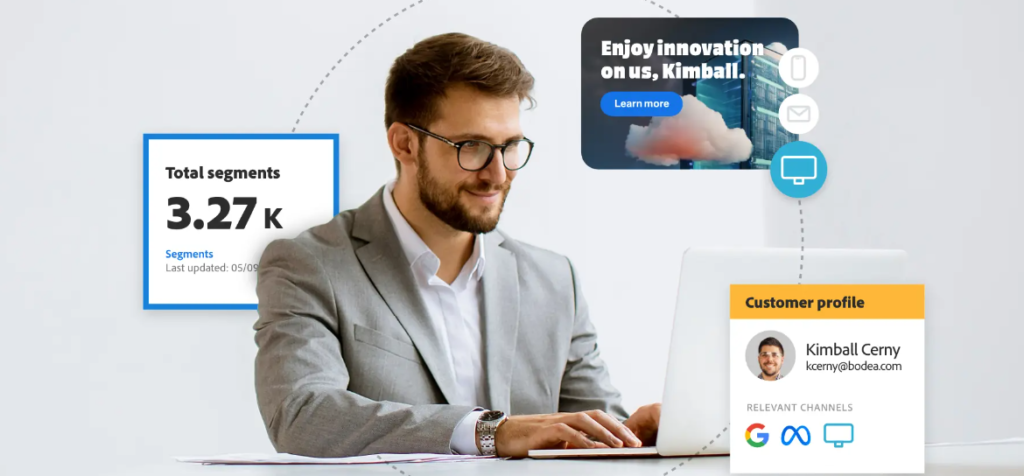Frequently Asked CDP Questions
March 23, 2017Here’s a list of common CDP questions and answers. These apply to CDPs in general but details may vary for specific systems. Thanks to Barbara Saxby of Accelant Consulting for formulating many of the questions.
What’s a CDP? The CDP Institute defines a Customer Data Platform (CDP) as “a marketer-managed system that creates a persistent, unified customer database that is accessible to other systems”. That is, a CDP ingests customer-related data from multiple source systems, cleans and unifies it to create a single customer view, and makes it available for other marketing systems to use. Some CDPs provide additional functions such as analytics, predictive modeling, content recommendations, and campaign management. Note that CDPs are commercial software products; custom-built software or a collection of commercial components could do the same thing but they wouldn’t be a CDP.
How does a CDP differ from a DMP? Data Management Platforms (DMPs) support Web display advertising by maintaining a collection of Web browser cookies with attributes such as interests, demographics, and behaviors. Users select sets of cookies with desired attributes and send them to advertising systems, which deliver ads to those cookies when they appear on a Web site. Key differences from a CDP are: DMP cookies are generally anonymous, whereas CDP records are linked to identified individuals. DMP data is a list of attributes, while CDPs store very detailed information such as purchase transactions and details of Web behaviors. DMPs work primarily with Web data, while CDPs nearly always include data from offline systems such as CRM. Some DMPs have added CDP functions but it’s important to recognize that it’s not what they were originally designed to do.
How does a CDP differ from a data warehouse or data lake? Data warehouses and data lakes are usually enterprise-wide projects, which means they are not tailored to marketing needs. Data lakes are collections of data, usually in the same form as the original source systems, while data warehouses process the raw data to make it more usable. But neither type of system generally does the cross-channel identity resolution needed to build a single customer view. Data warehouses are designed primarily to support analysis, not direct customer interactions. Among other things, this means they are usually updated daily, weekly, or less often, while CDPs usually ingest data in real time and make it available quickly if not instantly. Most CDPs use the same data storage technologies as data lakes. The difference is the CDP has built-in features to do additional processing to make the data usable, while a data lake does not.
How does a CDP differ from CRM? CRM systems exist primarily to engage with customers. They capture data generated during those engagements but aren’t designed to import large volumes of data from other systems. Nor are they built to unify that data by matching different identifiers. Their database designs are optimized for direct customer interactions, which needs a different approach than a CDP, which is optimized for bulk processing and extracts. Adapting CRM designs to CDP purposes is pretty much impossible because the new design would be inefficient for the systems’ primary purpose. When CDP data is used by CRMs, the CDP data is usually restructured and supplemented with indexes so the CRM can use it effectively.
Can my company build its own CDP? Most CDPs are built using common technologies that your company could buy for itself, such as Hadoop. The main difference is that CDP vendors have added features such as connectors for common source systems, data preparation flows, and identity resolution processes. You company would need to build those for itself or to assemble, learn, deploy and managea collection of commercial products that do the same things. This would almost always take more time, cost more money, and be harder to maintain than a CDP. It would also give marketers less control.
How much work is needed to build and maintain a CDP? Less than you’re used to. Newer technologies like schema-less data stores and artificial intelligence-driven data preparation reduce set-up effort. Prebuilt modules for complex processes such as identity management eliminate custom development and simplify tuning to make the data ready for use. Standard connectors for common source and execution systems avoid custom integration projects. Users still need to decide what data they need and IT has to provide access. But most CDP deployments are still finished in weeks, not months or years.
What skills will I need to run a CDP? If you’re a marketer or marketing analyst, none. If you’re in marketing operations, a marketing technologist, or an IT person supporting marketing, you’ll need to arrange data access and provide some insight about the data in your source systems. The CDP vendor or a service partner will do the real technical work unless you want them to train you to do it for yourself. Marketers need more skills if the CDP includes analytic or campaign management features, but those are probably skills they already have or need to add regardless.
Does the CDP need a full-time person, a team, or a shared resource? Operating the CDP should be a part time job at most. Day-to-day tasks should be fully automated, so the operator simply needs to monitor the processes to be sure they’re running smoothly. Adding new data sources or integrating new applications will take some additional time but shouldn’t be major projects in most situations. Remember that technologies inside the CDP reduce the amount of manual effort. Again, using the CDP applications may take more labor but that’s work you’d be doing in other systems – and, in fact, the CDP eliminates many data preparation tasks, so most application users should actually be able to get more work done with a CDP in place. Don’t confuse CDPs with systems like marketing automation, where every new campaign is often set up by an expert user in marketing operations.
How much does a CDP cost? It depends on the CDP, data sources, volumes, and other factors. Some systems start at $50,000 per year or less for a mid-size business. Others start at $250,000 for an enterprise. Nearly any mid-size or larger company should be able to find a CDP they can afford if they look around a bit. What’s more important than the price is that a CDP should almost always be cheaper than alternative approaches. Most important of all, the CDP should deliver value that vastly outweighs its cost.
How long does a CDP take to implement? This also depends but it’s usually a matter of weeks unless you get hung up by organizational issues. It’s important to remember that CDP delivers clean, organized, actionable data, not just a data lake whose contents need further processing before they’re ready for use.
Who does the implementation? The vendor or a service partner should handle most of the technical work. Marketers and marketing operations staff need to provide guidance and corporate IT needs to provide access to company systems. Company staff can do more of the work if they want to take over operations after deployment. Some CDPs provide interfaces that make this easy; others are really built for a skilled technical user.
What is the level of experience required? No technical experience. You do need experience with your business and your company’s data to know what sources to ingest and what applications to support. The CDP vendor should be able to provide some advice on those topics based on its own previous experience.
Who defines the data requirements? The marketing and marketing operations team would identify sources. Analysts and campaign designers would identify preparation needed to make the data usable. Your IT staff, compliance, and security teams may also have some say in what gets loaded and how it can be used. The CDP vendor will provide guidance and may have a services team that can manage the process if you want them to.
Who does the aggregation? Aggregation, such as finding lifetime purchases per customer across all channels, is usually done within the CDP as part of the standard data preparation process. This assumes the aggregation rules are known in advance. Ad hoc aggregation might be done in an analytical application that’s part of the CDP or be done outside the CDP. Even ad hoc aggregations are usually easier because data from different sources has been standardized and tagged with customer identities.
What does maintaining the CDP look like? The CDP should allow automated data ingestion through APIs, batch loads, and other methods. Data preparation processes such as cleaning, standardization, transformations, and identity resolution should also run automatically. Operations staff will need to monitor the processes to ensure they run smoothly, explore any problems, and make adjustments when new sources are added, preparation flows are adjusted, or new output formats are needed. Making such changes requires an understanding of how existing processes work so operators can predict the result of an alteration. Exactly how much technical skill is needed will depend on the CDP interface and how much work is done by the vendor.
How is the CRM integrated? Most CDPs have standard connectors for CRM systems such as Salesforce. The integration would always read data from CRM. A CDP is technically capable of pushing data back into the CRM, but not all users want to do this. The CDP may also let CRM users view data, such as detailed Web behavior histories, without actually copying it into the CRM files. CDPs with analytical or campaign management functions are more likely to push data into CRM for execution.
How does CDP feed into my marketing automation tools? Marketing automation would be another source system for customer data and for events such as email sends and responses. What goes back into marketing automation will depend on the system. Some marketing automation systems have built-in databases, so the CDP would only feed attributes such as aggregated lifetime value or predictive model scores. Some marketing automation systems might take a customer ID from the CDP so they can identify duplicates within the marketing automation database. Marketing automation systems that don’t have their own database might connect directly to the CDP or to data extracted from the CDP and placed in a format the marketing automation system can accept.
Do the content management applications need to integrate with the CDP? There’s no requirement that content management integrate, especially if content management doesn’t contain information about which customers saw which content. But some CDPs can ingest content objects and analyze them, for example using natural language processing to extract topics, tone, keywords, and other attributes. Such information could be used to analyze content effectiveness and to make individual-level content recommendations. This is an area where CDPs vary widely.
How seamless are predictive profiling and other tool integrations? In some cases, prebuilt or custom connectors will let predictive tools read the CDP data directly or read extracts that are generated automatically. In other cases, the predictive systems will be connected through APIs that let the model builder choose which data to extract on a case-by-case basis. Some systems may work with file extracts rather than API connections, although this is more likely to be due to limits of the predictive tool than the CDP. The CDP should always be able to present the data in a format the predictive tool can use. Adding externally generated scores to the CDP is usually simple, since it’s a straight data feed with a stable structure.
If marketing owns the CDP, what is the required IT Involvement? The only essential IT involvement is to arrange for data access by the CDP and for user access to the CDP. Optionally, IT may play a role in operating the CDP itself, especially if the CDP runs on-premise.


